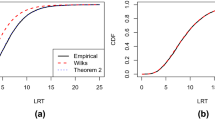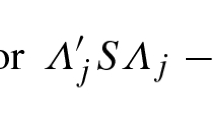Abstract
We develop a general approach to factor analysis that involves observed and latent variables that are assumed to be distributed in the exponential family. This gives rise to a number of factor models not considered previously and enables the study of latent variables in an integrated methodological framework, rather than as a collection of seemingly unrelated special cases. The framework accommodates a great variety of different measurement scales and accommodates cases where different latent variables have different distributions. The models are estimated with the method of simulated likelihood, which allows for higher dimensional factor solutions to be estimated than heretofore. The models are illustrated on synthetic data. We investigate their performance when the distribution of the latent variables is mis-specified and when part of the observations are missing. We study the properties of the simulation estimators relative to maximum likelihood estimation with numerical integration. We provide an empirical application to the analysis of attitudes.
Similar content being viewed by others
References
Akaike H., (1987). Factor analysis and AIC.Psychometrika, 52, 317–332.
Anderson, E.B. (1980).Discrete statistical models with social science applications. New York, NY: North Holland.
Anderson, T.W., & Rubin, H. (1956). Statistical inference in factor analysis.Proceedings of the third Berkeley Symposium in Mathematical Statistics and Probability, 5, 111–150.
Ansari, A., & K. Jedidi (2000). Bayesian factor analysis for multilevel binary observations.Psychometrika, 475–496.
Arminger, G., & Kusters, U. (1988). Latent trait models with indicators of mixed measurement level, In R. Langeheine & J. Rost (Eds.),Latent trait and latent class models (pp. 51–71). New York, NY: Plenum.
Bartholomew, D.J. (1988). The sensitivity of latent trait analysis to choice of prior distribution.British Journal of Mathematical and Statistical Psychology, 41, 101–107.
Bartholomew, D.J., & Knott, M. (1999).Latent variable models and factor analysis (Kendalls Library of Statitics, No. 7, 2nd. ed.). New York, NY: Edward Arnold.
Bozdogan, H. (1987). Model selection and Akaike's information criterion (AIC): The general theory and its analytical extensions.Psychometrika, 52, 345–370.
Fahrmeier, L., & Tutz, G. (1991).Multivariate statistical modeling based on generalized linear models. New York, NY: Springer-Verlag.
Geweke, J.M. (1988). Anthitetic acceleration of Monte Carlo integration in Bayesian inference.Journal of Econometrics, 57, 1317–1339.
Geweke, J., Keane, M., & Runkle, D. (1994). Alternative computational approaches to inference in the multinomial probit model.Review of Economics and Statistics, 76(4), 609–632.
Gill, R.D. (1977). Consistency of maximum likelihood estimator of the factor analysis model when the observations are not multivariate normal. In J.R. Bara, F. Brodeau, G. Romier, & B. van Custem (Eds.),Recent developments in statistics (pp. 437–440). Amsterdam: North Holland.
Gouriéroux, C., & Monfort, A. (1997).Simulation based econometric methods. New York, NY: Oxford University Press.
Haberman, S.J. (1982). Analysis of dispersion of multinomial responses.Journal of the American Statistical Association, 77, 568–580.
Kamakura, W.A., & Wedel, M. (2000). Factor analysis and missing data.Journal of Marketing Research, 37, 490–498.
Lee, L.F. (1995), Asymptotic bias in simulated maximum likelihood estimation of discrete choice models.Econometric Theory, 11, 437–483.
Lee, L.F. (1997). Simulated maximum likelihood estimation of dynamic discrete choice statistical models: Some Monte Carlo results.Journal of Econometrics, 82, 1–35.
Lee, L.F. (1999). Statistical inference with simulated likelihood functions.Econometric Theory, 15, 337–351.
Little, R.J.A., & D.B. Rubin (1987).Statistical analysis with missing data. New York, NY: Wiley.
McFadden, D. (1989). A method of simulated moments for estimation of discrete response models without numerical integration.Econometrika, 57, 995–1026.
McKay, M.D., Conover, W.J. & Beckman, R.J. (1979). A Comparison of three methods for selecting values of input variables in the analysis of output from a computer code.Technometrics, 21, 239–245.
Moustaki, I. (1996). A latent trait and latent class model for mixed observed variables.British Journal of Mathematical and Statistical Psychology, 49, 313–334.
Moustaki, I., & Knott, M. (2000). Generalized latent trait models.Psychometrika, 65, 391–411.
Mulaik, S.A. (1972).The foundations of factor analysis. New York, NY: McGraw Hill.
Muthén, B.O. (1984). A general structural model with dichotomous, ordered categorical and continuous latent variable indicators.Psychometrika, 49, 115–132.
Owen, A. (1992). Orthogonal arrays for computer experiments, integration and visualization.Statistica Sinica, 2, 439–452.
Sammel, M.D., Ryan, L.M., & Legler, J.M. (1997). Latent variable models for mixed discrete and continuous outcomes.Journal of the Royal Statistical Society, Series B, 59(3), 667–678.
Sándor, Z., & András, P. (2000).Alternative sampling methods for estimating multivariate normal probabilities (Working Paper). Groningen, Netherlands: University of Groningenm Faculty of Economics.
Scales, L.E. (1985).Introduction to non-linear optimization. London: Macmillan.
Seong, T.J. (1990). Sensitivity of marginal maximum likelihood estimation of item and ability parameters to the characteristics of the prior ability distributions.Applied Psychological Measurement, 14, 299–311.
Stern, S. (1997). Simulation-based estimation.Journal of Economic Literature, 35(December), 2006–2039.
Tang, B. (1993). Orthogonal array-based hypercubes.Journal of the American Statistical Association, 88, 1392–1397.
Author information
Authors and Affiliations
Corresponding author
Rights and permissions
About this article
Cite this article
Wedel, M., Kamakura, W.A. Factor analysis with (mixed) observed and latent variables in the exponential family. Psychometrika 66, 515–530 (2001). https://doi.org/10.1007/BF02296193
Received:
Revised:
Issue Date:
DOI: https://doi.org/10.1007/BF02296193




